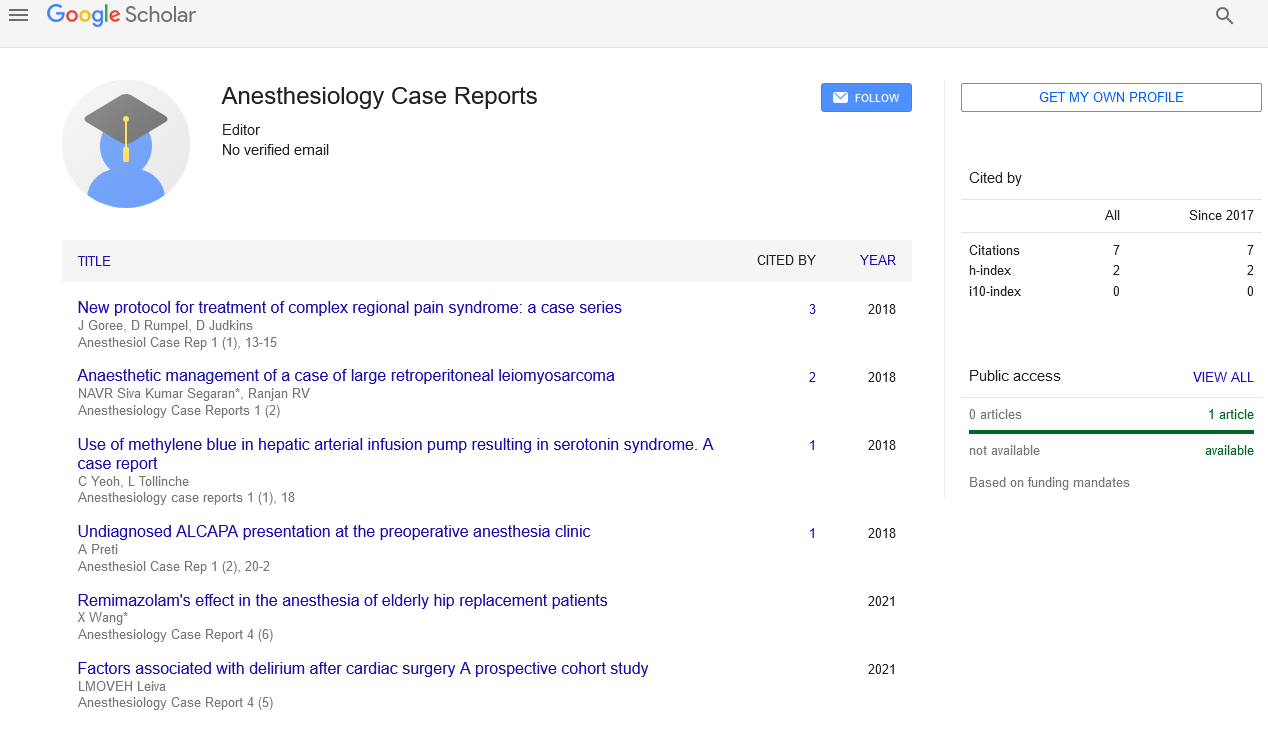Analgesia: A comprehensive overview
Received: 07-Aug-2024 Editor assigned: 09-Aug-2024 Accepted Date: Sep 05, 2024; Reviewed: 13-Aug-2024 Revised: 26-Aug-2024 Published: 07-Sep-2024
Citation: Saiperaki L. J. Analgesia: A comprehensive overview. Anesthesiol: Case Rep. 2024; 7(5):1-2.
This open-access article is distributed under the terms of the Creative Commons Attribution Non-Commercial License (CC BY-NC) (http://creativecommons.org/licenses/by-nc/4.0/), which permits reuse, distribution and reproduction of the article, provided that the original work is properly cited and the reuse is restricted to noncommercial purposes. For commercial reuse, contact reprints@pulsus.com
Abstract
Analgesia, the relief of pain, is a crucial component of medical practice that significantly impacts patient quality of life and recovery. This article explores the various types of analgesia, the mechanisms by which pain relief is achieved, the pharmacological agents employed, and the nonpharmacological approaches to pain management. By understanding these elements, healthcare professionals can implement effective strategies to alleviate pain and enhance patient care.
Introduction
Pain is a universal experience that affects individuals across all demographics. It serves as a vital biological signal that alerts us to injury or illness, but when it becomes chronic or severe, it can significantly impair daily functioning and diminish quality of life. Analgesia, defined as the relief of pain, is a cornerstone of patient care in various medical settings, from acute post-surgical pain management to chronic pain conditions .
Effective analgesia involves a multifaceted approach, combining pharmacological treatments with non-pharmacological interventions tailored to the individual needs of patients. The goal is not just to eliminate pain but to improve overall well-being and functionality. This article aims to provide a comprehensive overview of analgesia, focusing on its types, mechanisms, agents used, and the importance of a holistic approach in pain management.
Types of analgesia
Analgesia can be categorized based on several criteria, including duration, mechanism, and the underlying cause of pain. The primary categories include:
Acute analgesia: This refers to the management of pain that arises suddenly, often due to injury or surgical procedures. Acute pain typically lasts for a short period and can be effectively treated with a variety of medications and therapies.
Chronic analgesia: Chronic pain persists for longer periods, often defined as pain lasting beyond three to six months. Conditions such as arthritis, fibromyalgia, and neuropathic pain fall into this category. Managing chronic pain can be complex, often requiring a multidisciplinary approach .
Procedural analgesia: This type focuses on pain relief during specific medical procedures, such as biopsies or endoscopies. It may involve local anesthetics or sedatives to minimize discomfort.
Palliative analgesia: In cases of terminal illness, palliative analgesia aims to improve the quality of life by managing pain and other distressing symptoms. The emphasis is on comfort rather than curative treatment.
Mechanisms of analgesia
Understanding how analgesia works is essential for effective treatment. Pain can be categorized into two primary types:
Nociceptive pain: This type arises from tissue damage and is typically sharp or aching. It is often managed with non-opioid analgesics like acetaminophen or NSAIDs, which target the inflammatory processes associated with pain.
Neuropathic pain: Neuropathic pain results from damage to the nervous system itself and can manifest as burning, tingling, or shooting sensations. This type of pain often requires different pharmacological interventions, such as anticonvulsants or antidepressants, to manage effectively.
Pharmacological agents in analgesia
A wide array of pharmacological agents are available for managing pain, each with its own mechanisms and indications:
Acetaminophen: Commonly used for mild to moderate pain relief, acetaminophen is often the first-line treatment due to its effectiveness and safety profile. It works primarily in the central nervous system to inhibit pain perception.
Non-Steroidal Anti-Inflammatory Drugs (NSAIDs): These medications, including ibuprofen and naproxen, reduce pain and inflammation by inhibiting Cycloo Xygenase (COX) enzymes, which play a crucial role in producing inflammatory mediators .
Opioids: Opioids are potent analgesics used for moderate to severe pain. They act by binding to specific receptors in the brain and spinal cord, altering the perception of pain. While effective, opioids carry risks of dependency, tolerance, and potential side effects such as respiratory depression and constipation. Common opioids include morphine, oxycodone, and fentanyl.
Adjuvant analgesics
These medications, while not primarily designed for pain relief, can enhance the effectiveness of analgesics when used in combination. Examples include:
Antidepressants: Certain types, such as tricyclic antidepressants and serotonin-norepinephrine reuptake inhibitors, have been found to be effective in treating neuropathic pain.
Anticonvulsants: Medications like gabapentin and pregabalin can help stabilize nerve activity and reduce neuropathic pain.
Non-pharmacological approaches to analgesia
In addition to medications, non-pharmacological approaches are increasingly recognized as valuable components of pain management:
Physical therapy: Exercise and rehabilitation can enhance mobility, strengthen muscles, and reduce pain, particularly in musculoskeletal conditions.
Cognitive Behavioral Therapy (CBT): This psychological approach helps patients manage pain by altering their perceptions and reactions to pain, promoting effective coping strategies.
Acupuncture: This traditional Chinese medicine technique may provide pain relief by stimulating specific points on the body, potentially influencing pain pathways.
Mindfulness and relaxation techniques: Practices such as meditation, yoga, and deep breathing exercises can help reduce stress and improve pain management by altering the brain’s response to pain.
Massage therapy: Therapeutic massage can alleviate muscle tension, promote relaxation, and provide pain relief, particularly in chronic pain conditions.





